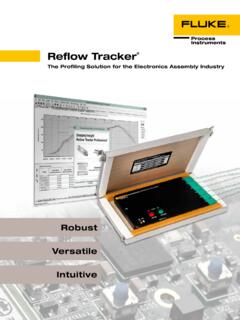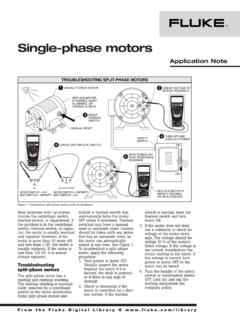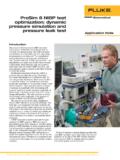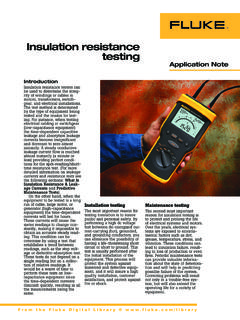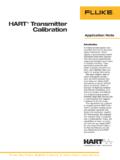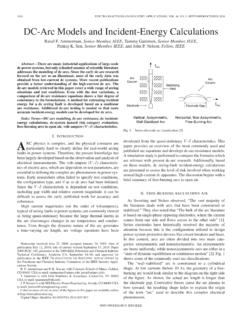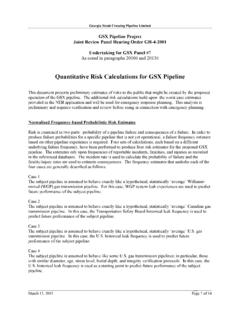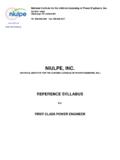Transcription of Quick reference guide to infrared thermometer calibration
1 infrared theoryCalibrationInfrared thermometersBlackbody theory Planck s LawDescribes the amount of spectral radiance emitted by a perfect blackbody at a given temperature, wavelength and solid s Displacement LawShows the peak wavelength for a given temperature (as predicted by Planck s Law).Planck s Law and Wien s Displacement Law 1e+0081e+0071e+0061e+0051e+0041e+0031e+0 021e+0011e+0001e-0010 2 4 6 8 10 12 14 16 18 20 Wavelength ( m)Spectral radiance [W(m sr)]T = 5000 CT = 1000 CT = 500 CT = 200 CT = 100 CT = 23 CT = -50 CPlanck s Law for various temperaturesWien s Displacement Law8-14 m band. The 8 14 is the spectral band used for most handheld infrared LawShows the total irradiance in the entire electro-magnetic constantsNameSymbolValueFirst radiation constant for spectral radiance 042 759 e8 W m4m-2sr -1 Second radiation 7752 e4 m KWien Wavelength Displacement Law constant (Third radiation constant) 7685 e3 m KStefan-Boltzmann 400 e-8 Wm-2 K-4 Sakuma Hattori Equation (Planckian Form)The Sakuma-Hattori Equation is used to approximate Planck s Law for instruments with non-finite bandwidth.
2 It can be used for a determination of temperature from radiance, or it can be used for determination of uncertainties using generalized constants for 8-14 m Band:A = mB = m KC = (unitless)Use KelvinsWhen doing calculations with any of the equations above, be sure do the calculations using kelvins, not degrees s Law and EmissivityFor energy incident on a surface, the ratios of the energy reflected, transmitted and emitted sum to unity. When a surface is opaque, the emitted and reflected energy sum to unity. The emissivity is the ratio a surface of temperature (T) emits when compared to a perfect blackbody of the same object has an emissivity less than unity. The energy exiting an opaque surface is a combination of reflected and emitted energy. It is important to note that emissivity is not necessarily constant over all 5 10 15 20 25 30 35 40 Diameter (mm)Percentage field of viewMeasurement equationGeneralized measurement equationThe true temperature of the surface being for the effects of uncertainty in reflected for the effects of uncertainty in calculate the error based on any of these elements, simply perform the following calculation: Effects of emissivity uncertaintyTo calculate the effects of emissivity uncertainty, ASTM E2758 provides the equation to the right.
3 Any S(T) involves a calculation using the Sakuma-Hattori the various spectral bands, the following graph shows the results error based on the following and the electro-magnetic spectrumCalibration schemesScheme I Contact traceabilityScheme II Radiometric traceabilityNMI ITS-90 ITS-90 Precision BlackbodyContact thermometerTraceable Radiation thermometer (TRT) l1 reference radiation sourceReference radiation source T measurementEmissivity correction Radiation thermometerRadiation thermometer l2l1 l2 What is an infrared thermometer ? infrared thermometers are a subset of radiation thermometers. These devices measure infrared radiation and display a temperature based on the radiation measured by the infrared thermometer and the emissivity setting of the infrared thermometer . The term infrared thermometer generally refers to handheld devices with a thermopile detector. Some other names used for infrared thermometers are IR guns, point and shoot thermometers, spot pyrometers, laser detectorsEssentially, a thermopile is a number of thermocouple junctions joined in series.
4 The radiation strikes a drum-like disk, causing it to heat. A ring forms a surface for the reference temperature. The voltage of the thermopile is measured and a temperature is assigned to that voltage, similar to what is done with thermocouple thermometer opticsSize-of-source effect, field of view and D:S ratioSize-of-source, field-of-view and distance to size ratio refer to optical characteristics of the IR thermometer . In the case of field of view and distance to size ratio, both specifications refer to a diameter, a measuring distance and a percentage of energy within the diameter. This means that even though a radiation thermometer has a given source diameter, there is still some measurement coming from outside that diameter. This is called the example to the right, a radiation thermometer s field of view has been measured at various diameters at a fixed measuring distance. In this example, the radiation thermometer measured 90 % of the target s energy within a diameter of 19 mm.
5 If the measuring distance is 400 mm, then the field of view would be specified as: 19 mm diameter (90 %), measuring distance: 400 mm. Source: IEC/TS 62492-1 Quick reference to infrared thermometer calibrationTSBBSREFL SBB(1- )SREFLSTOT = SBB + (1- )SREFL Real-body Blackbody210-1-2-3-4 Error ( C)0 100 200 300 400 500 Temperature ( C)Effects of a 1% error in emissivity 8 m to14 m 5 exp - 1c2 TL( ,T) = c1L PEAKT = c3 c1LM = T4 = d 0 5 exp - 1c2 TS = exp - 1c2AT + BC = -c2 Aln +1 CSBA1 = + + tFor opaque surfaces:t = 0 1 = + S ( TMEAS) = S ( TSURF) + [ S ( TREFL) - S ( TDET) ] ( 1 - IRT) IRT+ [ S ( TSURF) - S ( TREFL) ] ( SURF - IRT) IRTerror = S (TMEAS) - S (TSURF) Radiometric calibration to account for emissivity Large enough target to reproduce calibration geometry thermometer emissivity setting compensationerror = [ S ( TSURF) - S ( TREFL) ] ( SURF - IRT) IRTerror = [ S ( TREFL) - S ( TDET) ] (1 - IRT) IRTE ffects of reflected temperatureUncertainty budget structureBlackbody calibration temperature (VTBB) Impurities (FPBB) Plateau identification (FPBB) Blackbody emissivity, isothermal Blackbody emissivity, non-isothermal (VTBB) Reflected ambient radiation Cavity bottom heat exchange Convection (VTBB) Cavity bottom uniformity (VTBB) Ambient conditions (VTBB) VTBB: Variable Blackbody scheme only FPBB.
6 Fixed Point Blackbody scheme onlyRadiation thermometer Size-of-source effect Non-linearity reference temperature Ambient temperature Atmospheric absorption Gain ratios NoiseUse Interpolation error Drift Unknown temperature(based on BIPM CCT-WG5 on Radiation Thermometry, Uncertainty Budgets for calibration of Radiation Thermometers below the Silver Point)Classification of instrumentsPoint measurement: Radiation thermometers1D Measurement: Line scanners2D Measurement: Thermal imagersClosed focus90%Open focusField of view example90%SSDI nfrared thermometer modelsModelMeasuring rangeD:SFluke 561-40 C to 550 C(-40 F to 1022 F)12:1 Fluke 566-40 C to 650 C (-40 F to 1202 F)30:1 Fluke 568-40 C to 800 C (-40 F to 1472 F)50:1 Fluke 572-30 C to 900 C (-40 F to 1652 F)50:1 or 60:1 Fluke 574-30 C to 900 C (-40 F to 1652 F)50:1 or 60:1X-raysGamma-raysUVVisible lightIR (Devisions based on CIE scheme)MicrowavesRadio wavesNear IRSWIRMWIRLWIRFar IRRadarCell phoneFM BroadcastAM m15 mm(Not to scale) 2011 Fluke Corporation.
7 9/2011 4100366A G-ENThe Fluke calibration 4180 and 4181 Precision infrared Calibrators= [S(T)]2 exp c2AT + B S TAc2C(AT + B)





